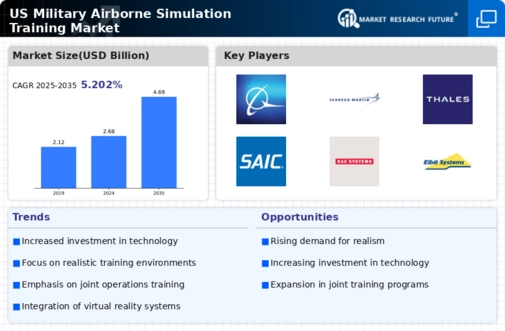Increased Defense Budgets
The military airborne-simulation-training market is experiencing growth due to increased defense budgets across various branches of the U.S. military. In recent years, the U.S. government has allocated substantial funds to enhance training capabilities, with a focus on advanced simulation technologies. For instance, the Department of Defense (DoD) has earmarked over $700 billion for defense spending in 2025, which includes investments in training systems. This financial commitment indicates a strong emphasis on improving operational readiness and effectiveness through simulation training. As a result, the The market is likely to benefit from this trend, as more resources are directed towards developing and implementing sophisticated training solutions.
Emphasis on Enhanced Safety Protocols
The military airborne-simulation-training market is increasingly shaped by the emphasis on enhanced safety protocols during training exercises. With the inherent risks associated with airborne operations, military organizations are prioritizing safety to protect personnel and equipment. Simulation training provides a safe environment for pilots and crew members to practice critical skills without the dangers of live flight. This focus on safety is reflected in the growing adoption of simulation technologies, which allow for comprehensive training without the associated risks. As safety becomes a paramount concern, the military airborne-simulation-training market is likely to see continued investment and growth.
Focus on Realistic Training Environments
The military airborne-simulation-training market is driven by the increasing demand for realistic training environments that closely mimic actual combat scenarios. Military leaders recognize that traditional training methods may not adequately prepare personnel for the complexities of modern warfare. Consequently, there is a growing emphasis on immersive simulation technologies that provide realistic experiences. According to recent estimates, the market for simulation-based training is projected to grow at a CAGR of 8% through 2027. This shift towards realism in training is likely to enhance the effectiveness of military operations, thereby propelling the military airborne-simulation-training market forward.
Technological Advancements in Simulation Systems
Technological advancements play a crucial role in shaping the military airborne-simulation-training market. Innovations in virtual reality (VR), augmented reality (AR), and artificial intelligence (AI) are transforming how training is conducted. These technologies enable the creation of highly interactive and adaptive training modules that can cater to individual learning needs. For example, AI-driven analytics can assess trainee performance in real-time, allowing for immediate feedback and tailored training experiences. As these technologies continue to evolve, they are expected to enhance the capabilities of simulation systems, thereby driving growth in the military airborne-simulation-training market.
Rising Demand for Cost-Effective Training Solutions
The military airborne-simulation-training market is also influenced by the rising demand for cost-effective training solutions. As military budgets face scrutiny, there is a pressing need to optimize training expenditures. Simulation training offers a viable alternative to traditional methods, as it reduces the costs associated with live training exercises, such as fuel, maintenance, and equipment wear. Reports indicate that simulation training can reduce overall training costs by up to 30%. This financial advantage, coupled with the ability to conduct training in a controlled environment, positions the military airborne-simulation-training market as a preferred choice for military organizations seeking efficiency.




















Leave a Comment